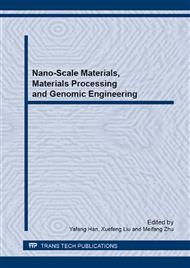[1]
S. Wang, A. C. A. Wan, X. Xu, S. Gao, H. Mao, K. W. Leong, and H. Yu:'A new nerve guide conduit material composed of a biodegradable poly(phosphoester)', Biomaterials. 22(2001) 1157-1169.
DOI: 10.1016/s0142-9612(00)00356-2
Google Scholar
[2]
A. S. Chandure S. S. Umare and R. A. Pandey:'Synthesis and biodegradation studies of 1,3-propanediol based aliphatic poly(ester carbonate)s', Eur.Polym. J.,44(2008) 2068-2086.
DOI: 10.1016/j.eurpolymj.2008.01.001
Google Scholar
[3]
Y. Yu, D. Wu, C. Liu, Z. Zhao, Y. Yang, and Q. Li:'Lipase/esterase-catalyzed synthesis of aliphatic polyesters via polycondensation: A review', Process Biochem. 47(2012) 1027-1036.
DOI: 10.1016/j.procbio.2012.04.006
Google Scholar
[4]
W. Liu, B. Chen, F. Wang, T. Tan, and L. Deng:'Lipase-catalyzed synthesis of aliphatic polyesters and properties characterization', Process Biochem. 46(2011) 1993-2000.
DOI: 10.1016/j.procbio.2011.07.008
Google Scholar
[5]
W. Zhu, C. Li, D. Zhang, G. Guan, Y. Xiao, and L. Zheng:'Thermal degradation mechanism of poly(butylene carbonate)',Polym.Degrad.Stabil. 97(2012) 1589-1595.
DOI: 10.1016/j.polymdegradstab.2012.06.029
Google Scholar
[6]
L. Ghasemi-Mobarakeh, M. P. Prabhakaran, M. Morshed, M. Nasr-Esfahani, and S. Ramakrishna: 'Electrospun poly(ε-caprolactone)/gelatin nanofibrous scaffolds for nerve tissue engineering', Biomaterials.29(2008) 4532-4539.
DOI: 10.1016/j.biomaterials.2008.08.007
Google Scholar
[7]
W. Huang, X. Shi, L. Ren, C. Du, and Y. Wang:'PHBV microspheres - PLGA matrix composite scaffold for bone tissue engineering', Biomaterials.31(2010) 4278-4285.
DOI: 10.1016/j.biomaterials.2010.01.059
Google Scholar
[8]
H. C. Ni, Z. Y. Lin, S. H. Hsu, and I. M. Chiu: 'The use of air plasma in surface modification of peripheral nerve conduits',ActaBiomaterialia.6(2010) 2066-2076.
DOI: 10.1016/j.actbio.2009.12.038
Google Scholar
[9]
S. Chang and C. Chian:'Plasma surface modification effects on biodegradability and protein adsorption properties of chitosan films', Appl. Surf. Sci.282(2013) 735-740.
DOI: 10.1016/j.apsusc.2013.06.044
Google Scholar
[10]
K. H. Lee, H. Y. Kim, H. J. Bang, Y. H. Jung, and S. G. Lee:'The change of bead morphology formed on electrospun polystyrene fibres', Polymer.44(2003) 4029-4034.
DOI: 10.1016/s0032-3861(03)00345-8
Google Scholar
[11]
P. K. Baumgarten:'Electrostatic spinning of acrylic microfibres', J Colloid Interf. Sci. 36(1971) 71-79.
Google Scholar
[12]
M. Deng, G. Chen, D. Burkley, J. Zhou, D. Jamiolkowski, Y. Xu, and R. Vetrecin:'A study on in vitro degradation behavior of a poly(glycolide-co-l-lactide) monofilament', ActaBiomaterialia.4(2008) 1382-1391.
DOI: 10.1016/j.actbio.2008.03.011
Google Scholar
[13]
J. Chen and C. Su:'Surface modification of electrospun PLLA nanofibres by plasma treatment and cationized gelatin immobilization for cartilage tissue engineering', ActaBiomaterialia.7(2011) 234-243.
DOI: 10.1016/j.actbio.2010.08.015
Google Scholar
[14]
G. M. L. Messina C. Satriano and G. Marletta:'A multitechnique study of preferential protein adsorption on hydrophobic and hydrophilic plasma-modified polymer surfaces', Colloids and Surfaces B: Biointerfaces.70(2009) 76-83.
DOI: 10.1016/j.colsurfb.2008.12.013
Google Scholar
[15]
K. R. Kull M. L. Steen and E. R. Fisher:'Surface modification with nitrogen-containing plasmas to produce hydrophilic, low-fouling membranes', J Membrane Sci. 246(2005)203-215.
DOI: 10.1016/j.memsci.2004.08.019
Google Scholar
[16]
B. M. P. Ferreira, L. M. P. Pinheiro, P. A. P. Nascente, M. J. Ferreira, and E. A. R. Duek; 'Plasma surface treatments of poly(l-lactic acid) (PLLA) and poly(hydroxybutyrate-co-hydroxyvalerate) (PHBV)', Materials Science and Engineering: C.29(2009) 806-813.
DOI: 10.1016/j.msec.2008.07.026
Google Scholar
[17]
D. Bodas and C. Khan-Malek: 'Formation of more stable hydrophilic surfaces of PDMS by plasma and chemical treatments', Microelectron Eng. 83(2006) 1277-1279.
DOI: 10.1016/j.mee.2006.01.195
Google Scholar
[18]
E. Kim Q. Yu and B. Deng:'Plasma surface modification of nanofiltration (NF) thin-film composite (TFC) membranes to improve anti organic fouling', Appl. Surf. Sci. 257(2011) 9863-9871.
DOI: 10.1016/j.apsusc.2011.06.059
Google Scholar
[19]
S. D. Wolter J. R. Piascik and B. R. Stoner:'Characterization of plasma fluorinated zirconia for dental applications by X-ray photoelectron spectroscopy', Appl. Surf. Sci. 257(2011) 10177-10182.
DOI: 10.1016/j.apsusc.2011.07.013
Google Scholar
[20]
H. K. Dhiman A. R. Ray and A. K. Panda:'Three-dimensional chitosan scaffold-based MCF-7 cell culture for the determination of the cytotoxicity of tamoxifen', Biomaterials. 26(2005) 979-986.
DOI: 10.1016/j.biomaterials.2004.04.012
Google Scholar
[21]
X. Kang, Y. Xie, H. M. Powell, L. James Lee, M. A. Belury, J. J. Lannutti, and D. A. Kniss:'Adipogenesis of murine embryonic stem cells in a three-dimensional culture system using electrospun polymer scaffolds', Biomaterials.28(2007) 450-458.
DOI: 10.1016/j.biomaterials.2006.08.052
Google Scholar
[22]
S. Y. Chew, R. Mi, A. Hoke, and K. W. Leong:'The effect of the alignment of electrospun fibrous scaffolds on Schwann cell maturation', Biomaterials.29(2008) 653-661.
DOI: 10.1016/j.biomaterials.2007.10.025
Google Scholar
[23]
P. Arpornmaeklong P. Pripatnanont and N. Suwatwirote:'Properties of chitosan–collagen sponges and osteogenic differentiation of rat-bone-marrow stromal cells', Int. J Oral Ma. Surg. 37(2008) 357-366.
DOI: 10.1016/j.ijom.2007.11.014
Google Scholar
[24]
J. Y. Lee, C. A. Bashur, A. S. Goldstein, and C. E. Schmidt:'Polypyrrole-coated electrospun PLGA nanofibres for neural tissue applications', Biomaterials.30(2009) 4325-4335.
DOI: 10.1016/j.biomaterials.2009.04.042
Google Scholar
[25]
S. Martino, F. D'Angelo, I. Armentano, J. M. Kenny, and A. Orlacchio:'Stem cell-biomaterial interactions for regenerative medicine', Biotechnol. Adv. 30(2012) 338-351.
DOI: 10.1016/j.biotechadv.2011.06.015
Google Scholar


